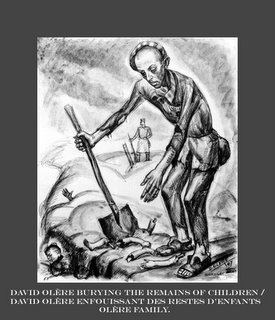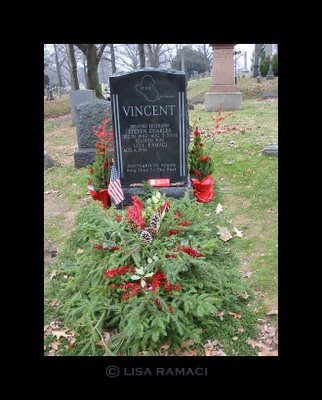Tribute to a Very Brave Man - David Olère, 1902 - 1985

The Food of the Dead for the Living by David Olère. 102x76 cm, A Living Memorial to the Holocaust, New York.
Olère collects food, abandoned near the undressing rooms of crematorium III at Birkenau, so he can throw it over the fence to the prisoners at the women's camp.
Olère collects food, abandoned near the undressing rooms of crematorium III at Birkenau, so he can throw it over the fence to the prisoners at the women's camp.
Text and main Resource:
David Olère at A Teacher's Guide to the Holocaust Produced by the Florida Center for Instructional Technology.
Inmate Art from Auschwitz and Birkenauat A Teacher's Guide to the Holocaust
Inmate Art from Auschwitz and Birkenauat A Teacher's Guide to the Holocaust
 David Olère - Drawings & Paintings
David Olère - Drawings & Paintings"The documentary value of the sketches and paintings of David Olère is tremendous. No actual photographs were taken of what went on within the crematoriums; only the hands and eyes of David Olère reproduce the horrible reality. David Olère did not sketch for pleasure. He sketched in testimony to all those who never came back. The lone witness (Olère himself) is often present. The ghostly face observes with pain the inhuman scenes that cannot be erased from his photographic memory.
The book, David Olère--The Eyes of a Witness, published by The Beate Klarsfeld Foundation in Paris in 1989, contains a three page summary of David Olère's life and one hundred pages of his artwork. All of the text appears in both English and French. Olère's pencil sketches and color paintings capture the everyday events in the concentration camps during the Holocaust. There are also portraits of some of the Nazi soldiers and layouts of the crematoriums.
A more recent book, Witness: Images of Auschwitz, combines Olère's artwork with text by his son, Alexandre Oler. Olère's artistry is truly one of the best and most important representations of the atrocities of the Holocaust.
Biography
David Olère is well-known as an artist whose work testifies to the enormity of the Holocaust. A survivor of Auschwitz, his drawings, paintings, and sculpture have helped considerably to reveal the truth about the atrocities suffered by Jews and other Nazi victims at this notorious death camp.
David Olère was born in Warsaw, Poland, on January 19, 1902. At a young age, he was accepted into the Academy of Fine Arts, and remained in Poland until he was sixteen. During his teenage years he exhibited woodcuts at museums and art houses in Danzig and Berlin. He was later hired by the Europäische Film Allianz as a painter, sculptor, and architect. So began his short career as a set designer in the film industry. Olère even worked briefly for Paramount Pictures in Europe, and befriended the company's president. In 1930 Olère was married to Juliette Ventura, and the couple moved to a French suburb. They had a son, Alexandre. Once war was declared in Europe, Olère was drafted into the infantry regiment at Lons-le-Saunier. On February 20, 1943, he was arrested by French police during a round up of Jews at Seine-et-Oise. Olère was detained at Drancy, then deported to Auschwitz.
 From March 2, 1943, to January 19, 1945, David Olère was interned at Auschwitz. There he worked as a Sonderkommando, part of a special labor unit responsible for emptying the remains from the ovens of the crematory and for removing the bodies from the gas chambers. The horrors he witnessed there are incomprehensible to anyone who did not personally experience the Holocaust. He saw the victims of the gas chamber undress in the cloakroom, paralyzed with fear and the knowledge of certain death.
From March 2, 1943, to January 19, 1945, David Olère was interned at Auschwitz. There he worked as a Sonderkommando, part of a special labor unit responsible for emptying the remains from the ovens of the crematory and for removing the bodies from the gas chambers. The horrors he witnessed there are incomprehensible to anyone who did not personally experience the Holocaust. He saw the victims of the gas chamber undress in the cloakroom, paralyzed with fear and the knowledge of certain death. He saw the incineration of countless bodies. He saw the so-called medical experiments performed on the weak and the sick and the old. He saw the SS rape and torture young Jewish girls. He saw prisoners suffer terrible cruelties while living under the most deplorable of conditions. And on a regular basis, he saw disease, despair, and death. David Olère was one of the few laborers to penetrate the dark interiors of the crematoria and the gas chambers of Auschwitz and to emerge alive. He took part in the evacuation death march of Auschwitz in January of 1945 and was finally liberated by the Americans at Ebensee in May of that year.
He saw the incineration of countless bodies. He saw the so-called medical experiments performed on the weak and the sick and the old. He saw the SS rape and torture young Jewish girls. He saw prisoners suffer terrible cruelties while living under the most deplorable of conditions. And on a regular basis, he saw disease, despair, and death. David Olère was one of the few laborers to penetrate the dark interiors of the crematoria and the gas chambers of Auschwitz and to emerge alive. He took part in the evacuation death march of Auschwitz in January of 1945 and was finally liberated by the Americans at Ebensee in May of that year.The work of David Olère has exceptional documentary value. No photographs were taken at Auschwitz of what went on in the gas chambers and crematoria. Only the memories of Olère, reproduced as art in his drawings and paintings, give an account of the horrible reality. He was the first to draw the plans and cross-sections of the crematories in order to explain exactly how the Nazis ran their death factory. He did not sketch for pleasure while at Auschwitz; there he was forced to work as an illustrator and to write and decorate letters for the SS. One of his paintings shows Olère painting designs on a lampshade. The works of art he produced after his release were created out of an obligation he felt to those who did not survive. He believed he had to tell the true story of their fate, and he did so in the best way he could, through his art.
 In his paintings he himself is sometimes present as a ghostly face, floating in the background, a silent, pained witness observing the inhuman scenes that could not ever be erased from his memory.
In his paintings he himself is sometimes present as a ghostly face, floating in the background, a silent, pained witness observing the inhuman scenes that could not ever be erased from his memory.In 1962, David Olère retired from his work as an artist. In 1985, he died. His widow and son have continued his twofold quest of informing the world of the truth about Auschwitz and honoring the victims by remembering their pain. Olère's paintings and drawings have been exhibited at several museums, but spreading his message presents a challenge. The paintings are frequently graphic and repulsive--the gruesome scenes seem to repel the audience rather than attract it. Yet his work only represents the truth, a goal the best of artists aspire to achieve.
 SOURCE: Serge Klarsfeld, David Olère: L'Oeil du Témoin/The Eyes of a Witness. New York: The Beate Klarsfeld Foundation, 1989."
SOURCE: Serge Klarsfeld, David Olère: L'Oeil du Témoin/The Eyes of a Witness. New York: The Beate Klarsfeld Foundation, 1989."The Book:
David Olère: Witness: Images of Auschwitz L'Oeil du Témoin/The Eyes of a Witness. New York: The Beate Klarsfeld Foundation, 1989The Art Works:

 Selection for Gas Chambers by David Olère. 1947, 41x51 cm, Ghetto Fighters House, Israel
Selection for Gas Chambers by David Olère. 1947, 41x51 cm, Ghetto Fighters House, IsraelMy First Dialogue by David Olère. 1949, 36x38 cm, Olère Family.
Subtitled: "They also are responsible for the war." "Yes, that's war.
Leaving for Work by David Olère. 1946, 43x33 cm, Ghetto Fighters House, Israel.
Camp inmates are marched out to work past victims of Nazi camp discipline.
The Oven Room by David Olère. 1945, 58x38 cm, Ghetto Fighters House, Israel.
A freight elevator in the background brought bodies up from the basement gassing chamber of Crematorium III at Birkenau. The wet trough at the right facilitated the dragging of bodies to the ovens.
Gassing by David Olère. 131x162 cm, A Living Memorial to the Holocaust, New York. The container in the lower right is labeled Zyklon B.

David Olère Burying the Remains of Children by David Olère. 32x40 cm, Olère Family.
Olère's first assignment at Auschwitz was as a grave digger of bunker 2. His prisoner number, 106144, is seen both on his shirt and as a tattoo on his left arm.
Arrival of a Convoy by David Olère. 65x50 cm, A Living Memorial to the Holocaust, New York.
A new convoy arrives in the background as inmates struggle with a cart carrying away cadavers from a previous convoy.
 For a Crust of Bread by David Olère. 1946, 21x27 cm, Olère Family.
For a Crust of Bread by David Olère. 1946, 21x27 cm, Olère Family.David Olère depicts himself writing letters for the SS and decorating them with flowers in exchange for a crust of bread. Olère's talents as an artist and translator (he spoke Polish, Russian, Yiddish, French, English, and German) made him useful to the SS.
Their Last Steps by David Olère. 73x54 cm, Ghetto Fighters House, Israel.

Text and main Resource:
David Olère at A Teacher's Guide to the Holocaust Produced by the Florida Center for Instructional Technology.
Inmate Art from Auschwitz and Birkenauat A Teacher's Guide to the Holocaust
More resources:
* Karsfled Foundation
David Olère - More Drawings & Paintings
Biography
A Holocaust Art Exhibit - Powerful Exibit at Modern American Peotry
The Last Jews - The Concentration Camp Universe and the Death Marches The New Museum
Yad Vashem - The Holocaust Martyrs' and Heroes' Remembrance Authority
David Olère and Alexander Olère
Art and the Holocaust
Mémorial de la Shoah - Selection du Mois - SCÉRÉN - CNDP
Memoire de Shoah - France
Images from Auschwitz-Birkenau
Auschwitz-Birkenau, then and now at Holocaust Info
Warsaw Virtual Jewish Library
Drancy - USHMM
Auschiwitz Memorial Musuem
Auschwitz - Camp Of Death Holocaust Teacher Resource Center
All Dissidents and Victims of Tyranny Want to Live in a Free Society







